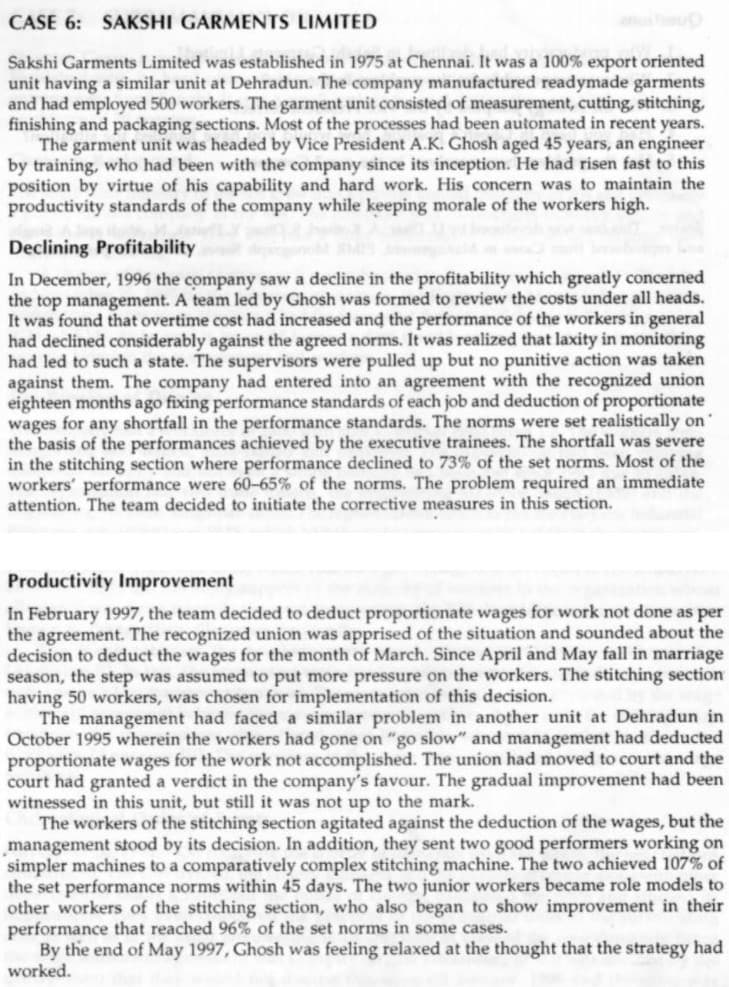Questions 1. Why productivity had declined in Sakshi Garments Limited? 2. Who was responsible for the problem in the case? 3. Was the strategy adopted by the Vice President correct?
Questions 1. Why productivity had declined in Sakshi Garments Limited? 2. Who was responsible for the problem in the case? 3. Was the strategy adopted by the Vice President correct?
Chapter1: Taking Risks And Making Profits Within The Dynamic Business Environment
Section: Chapter Questions
Problem 1CE
Related questions
Question
Questions
1. Why productivity had declined in Sakshi Garments Limited?
2. Who was responsible for the problem in the case?
3. Was the strategy adopted by the Vice President correct?
4. Had you been in Ghosh's position, how would you have handled the situation?
5. Has the problem been resolved in the case? Comment.

Transcribed Image Text:CASE 6: SAKSHI GARMENTS LIMITED
Sakshi Garments Limited was established in 1975 at Chennai. It was a 100% export oriented
unit having a similar unit at Dehradun. The company manufactured readymade garments
and had employed 500 workers. The garment unit consisted of measurement, cutting, stitching,
finishing and packaging sections. Most of the processes had been automated in recent years.
The garment unit was headed by Vice President A.K. Ghosh aged 45 years, an engineer
by training, who had been with the company since its inception. He had risen fast to this
position by virtue of his capability and hard work. His concern was to maintain the
productivity standards of the company while keeping morale of the workers high.
Declining Profitability
In December, 1996 the company saw a decline in the profitability which greatly concerned
the top management. A team led by Ghosh was formed to review the costs under all heads.
It was found that overtime cost had increased and the performance of the workers in general
had declined considerably against the agreed norms. It was realized that laxity in monitoring
had led to such a state. The supervisors were pulled up but no punitive action was taken
against them. The company had entered into an agreement with the recognized union
eighteen months ago fixing performance standards of each job and deduction of proportionate
wages for any shortfall in the performance standards. The norms were set realistically on
the basis of the performances achieved by the executive trainees. The shortfall was severe
in the stitching section where performance declined to 73%
workers' performance were 60-65% of the norms. The problem required an immediate
attention. The team decided to initiate the corrective measures in this section.
the set norms. Most of the
Productivity Improvement
In February 1997, the team decided to deduct proportionate wages for work not done as per
the agreement. The recognized union was apprised of the situation and sounded about the
decision to deduct the wages for the month of March. Since April and May fall in marriage
season, the step was assumed to put more pressure on the workers. The stitching section
having 50 workers, was chosen for implementation of this decision.
The management had faced a similar problem in another unit at Dehradun in
October 1995 wherein the workers had gone on "go slow" and management had deducted
proportionate wages for the work not accomplished. The union had moved to court and the
court had granted a verdict in the company's favour. The gradual improvement had been
witnessed in this unit, but still it was not up to the mark.
The workers of the stitching section agitated against the deduction of the wages, but the
management stood by its decision. In addition, they sent two good performers working on
simpler machines to a comparatively complex stitching machine. The two achieved 107% of
the set performance norms within 45 days. The two junior workers became role models to
other workers of the stitching section, who also began to show improvement in their
performance that reached 96% of the set norms in some cases.
By the end of May 1997, Ghosh was feeling relaxed at the thought that the strategy had
worked.
Expert Solution
This question has been solved!
Explore an expertly crafted, step-by-step solution for a thorough understanding of key concepts.
This is a popular solution!
Trending now
This is a popular solution!
Step by step
Solved in 2 steps

Recommended textbooks for you

Understanding Business
Management
ISBN:
9781259929434
Author:
William Nickels
Publisher:
McGraw-Hill Education

Management (14th Edition)
Management
ISBN:
9780134527604
Author:
Stephen P. Robbins, Mary A. Coulter
Publisher:
PEARSON

Spreadsheet Modeling & Decision Analysis: A Pract…
Management
ISBN:
9781305947412
Author:
Cliff Ragsdale
Publisher:
Cengage Learning

Understanding Business
Management
ISBN:
9781259929434
Author:
William Nickels
Publisher:
McGraw-Hill Education

Management (14th Edition)
Management
ISBN:
9780134527604
Author:
Stephen P. Robbins, Mary A. Coulter
Publisher:
PEARSON

Spreadsheet Modeling & Decision Analysis: A Pract…
Management
ISBN:
9781305947412
Author:
Cliff Ragsdale
Publisher:
Cengage Learning

Management Information Systems: Managing The Digi…
Management
ISBN:
9780135191798
Author:
Kenneth C. Laudon, Jane P. Laudon
Publisher:
PEARSON

Business Essentials (12th Edition) (What's New in…
Management
ISBN:
9780134728391
Author:
Ronald J. Ebert, Ricky W. Griffin
Publisher:
PEARSON

Fundamentals of Management (10th Edition)
Management
ISBN:
9780134237473
Author:
Stephen P. Robbins, Mary A. Coulter, David A. De Cenzo
Publisher:
PEARSON